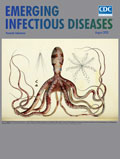
Volume 26, Number 8—August 2020
Research
Characterizing Norovirus Transmission from Outbreak Data, United States
Molly K. Steele , Mary E. Wikswo, Aron J. Hall, Katia Koelle, Andreas Handel, Karen Levy, Lance A. Waller, and Ben A. Lopman
, Mary E. Wikswo, Aron J. Hall, Katia Koelle, Andreas Handel, Karen Levy, Lance A. Waller, and Ben A. Lopman
Abstract
Norovirus is the leading cause of acute gastroenteritis outbreaks in the United States. We estimated the basic (R0) and effective (Re) reproduction numbers for 7,094 norovirus outbreaks reported to the National Outbreak Reporting System (NORS) during 2009–2017 and used regression models to assess whether transmission varied by outbreak setting. The median R0 was 2.75 (interquartile range [IQR] 2.38–3.65), and median Re was 1.29 (IQR 1.12–1.74). Long-term care and assisted living facilities had an R0 of 3.35 (95% CI 3.26–3.45), but R0 did not differ substantially for outbreaks in other settings, except for outbreaks in schools, colleges, and universities, which had an R0 of 2.92 (95% CI 2.82–3.03). Seasonally, R0 was lowest (3.11 [95% CI 2.97–3.25]) in summer and peaked in fall and winter. Overall, we saw little variability in transmission across different outbreaks settings in the United States.
Norovirus is the most common cause of outbreaks of acute gastroenteritis (AGE) in the United States (1,2). The Centers for Disease Control and Prevention (CDC) collects data on AGE outbreaks through the National Outbreak Reporting System (NORS). During 2009–2017, norovirus was the suspected or confirmed etiology of 47% of AGE outbreaks reported to NORS (3). The size and severity of outbreaks varies across different settings, times of year, and genotypes, suggesting norovirus transmissibility is variable across different outbreak settings and contexts (4). Generally, the transmission potential of infectious diseases is influenced by the infectiousness of the pathogen, the duration of infectiousness, and the number of susceptible contacts exposed during the infectious period (5).
The reproduction number is a metric for quantifying transmissibility of a pathogen. The basic reproduction number (R0) is the average number of secondary cases that arise from a primary case in a completely susceptible population. The effective reproduction number (Re) quantifies the average number of secondary cases that arise from a primary case in a population that is not completely susceptible. Re varies over the course of an outbreak as the proportion of the susceptible population changes (6,7). R0 and Re are not just metrics of the biologic properties of pathogens but also measures of the transmissibility of a pathogen within a specific population or setting (8,9).
Several transmission modeling studies in different settings have estimated R0 and Re of norovirus, but a large variation in these estimates occurs and R0 ranges from 1.1–7.2 (10). Much of the R0 variation likely is due to differences in the structures, population mixing assumptions, and data between transmission models in different settings (10). Generally, model estimates from community surveillance data result in an R0 of ≈2, but estimates from outbreak data tend to be higher and more variable. The variability of estimates from models that use outbreak data likely are driven by context; outbreaks might occur in populations that are not representative of the population as a whole and transmission likely is higher in these settings than in the community (4).
We estimated R0 and Re for thousands of norovirus outbreaks in the United States. We evaluated whether R0 was associated with setting, season, year, or geographic region. In addition, we assessed whether norovirus was suspected or confirmed as the cause of the outbreak.






















.png)











No hay comentarios:
Publicar un comentario